Table of contents
1.1 Basis and significance of topic selection
1.2 Research status and development trends at home and abroad
1.4 Introduction to ssm framework 2
1. 5 Paper structure and chapter arrangement 3
2Analysis of Hotel Reservation Management System 4
2.3.2Data modification process 5
2.3 System Function Analysis 5
2.3.2 Non-functional analysis 6
2.4 System use case analysis 7
3 Overall design of hotel reservation management system
3.1 System architecture design
3.2 System function module design
3.2.1 Overall functional module design
3.2. 3 Comment management module design
3.3.1 Database conceptual structure design
3.3.2 Database logical structure design
4 Detailed design and implementation of hotel reservation management system 2 0
4.1.3 User registration interface 23
4.1.4 Hotel announcement interface
4.1.6 Hotel information interface
4. 2 Administrator function module
4. 2.2 System user management interface
4. 2 .3 Hotel announcement management interface 30
4. 2 .4 Resource management interface 32
4. 2. 5 Module management interface
In the information society, there is a need for targeted ways to obtain information, but the expansion of the ways is basically the direction that people strive for. Due to deviations in the perspective, people can often obtain different types of information, which is also the most difficult to overcome with technology. subject. In view of issues such as hotel reservation management, the hotel reservation management system is researched and analyzed, and then a hotel reservation management system is developed and designed to solve the problem.
The main functional modules of the hotel reservation management system include hotel rooms, room types, reservation information, check-in information, checkout and check-out. The object-oriented development model is adopted for software development and hardware installation, which can well meet the needs of actual use. , perfected the corresponding software construction and program coding work, adopted MySQL as the main storage unit of back-end data, and used SSM framework, Java technology, and Ajax technology to code and develop the business system, realizing all the functions of this system. This report first analyzes the background, role, and significance of the research, laying the foundation for the rationality of the research work. Analyze the various needs and technical issues of the hotel reservation management system, prove the necessity and technical feasibility of the system, and then give a basic introduction to the technical software and design ideas that need to be used in the design system, and finally implement hotel reservation management System and deployment operations use it.
Keywords: hotel reservation management system; ssm; MYSQL
In the information society, there is a need for targeted information acquisition channels, but the expansion of channels is basically the direction of people's efforts. Due to the deviation in perspective, people often can obtain different types of information, which is also the most difficult topic for technology to overcome. Research and analyze the hotel reservation management system to address issues such as hotel reservation management, and then develop and design a hotel reservation management system to address these issues.
The main functional modules of the hotel reservation management system include hotel rooms, room types, reservation information, check-in information, and checkout. The system adopts an object-oriented development model for software development and hardware installation, which can effectively meet practical usage needs. It improves the corresponding software installation and program coding work, adopts MySQL as the main storage unit for backend data, and adopts SSM framework and Java technology Ajax technology is used for coding and developing business systems, achieving all the functions of this system. This report first analyzes the background, role, and significance of the research, laying the foundation for the rationality of the research work. Analyze the various requirements and technical issues of the hotel reservation management system, prove the necessity and technical feasibility of the system, and then provide a basic introduction to the technical software and design ideas required for designing the system. Finally, implement the hotel reservation management system and deploy it for operation.
Keywords:Hotel reservation management system; ssm; MYSQL
1 Introduction
1.1 Basis and significance of topic selection
Today with the rapid development of the Internet, it is very necessary to create a hotel reservation management system. This website is a customized hotel reservation management system using Java language based on the development of others. The front desk of the system realizes user registration, login, query and view of hotel information, and reservations. It can also view hotel announcements, hotel rooms and other functions. The backend of the system realizes the management of hotel announcements, hotel information, hotel rooms, room types, reservation information, check-in information, checkout and check-out and other functions. This article first introduces the technical development background and development status of the hotel management system, and then follows the regular software development process. First, it selects an appropriate language and development platform for the system, develops modules and designs database structures based on demand analysis, and then based on the overall functional modules of the system. Design and draw the functional module diagram, flow chart and ER diagram of the system. Then, design the framework and write code based on the designed framework to implement each functional module of the system. Finally, the initially completed system is tested, mainly functional testing, unit testing and performance testing. The test results show that the system can achieve the required functions and operates reasonably well without obvious shortcomings.
With the rapid development of society and the increasingly fierce competition in the catering industry, traditional manual management methods are no longer enough to meet the needs of hotel managers. Today, as computer science becomes increasingly mature, hotel managers have realized the importance of using computers to manage wine stations. importance. It will be more convenient to use computers to manage hotels, so it is necessary to develop a suitable hotel management system. According to the characteristics and actual situation of the hotel service industry, the hotel management system should highlight front desk management, focus on data analysis and other functions, and strive to provide managers with effective management methods.
1.2 Research status and development trends at home and abroad
Nowadays, more and more people are willing to choose a suitable management plan, but front desk customer service is often limited by management experience. At this time, with the continuous development of hotel management systems, a large number of management systems have entered people's lives, and hotel management systems It is undoubtedly the best system for hotel management. Under the background of such a successful management model, not only the number of hotels is increasing, but the services of the hotels are also constantly improving. As user demands continue to increase, the store management system is also facing bottlenecks. Managing hotel information efficiently and conveniently has become a top priority to transform the management model and be compatible with the times.
The hotel reservation management system provides users with a convenient way to view hotel information anytime and anywhere. More importantly, it greatly simplifies the way administrators manage hotel information. It also provides a reliable way for others who want to know hotel management information and operations. channel. Compared with traditional hotel information management methods, this kind of electronic information management is more concise and convenient. It also has unique advantages in maintaining feedback on hotel information and processing hotel information opinions.
1.3Vue.js main functions
Vue.js is a progressive framework for building user interfaces. Unlike other heavyweight frameworks, Vue adopts a bottom-up incremental development design. Vue's core library only focuses on the view layer, and is very easy to learn and integrate with other libraries or existing projects. Vue, on the other hand, is fully capable of driving complex single-page applications developed using single-file components and libraries supported by the Vue ecosystem.
The goal of Vue.js is to implement responsive data binding and composed view components through the simplest possible API.
Vue.js itself is not a full-featured framework - it only focuses on the view layer. Therefore it is very easy to learn and very easy to integrate with other libraries or existing projects. On the other hand, Vue.js can also power complex single-page applications when used with related tools and supporting libraries.
1.4 Introduction to ssm framework
The SSM (Spring+SpringMVC+MyBatis) framework set is integrated by the two open source frameworks Spring and MyBatis (SpringMVC is part of Spring). It is often used as a framework for web projects with relatively simple data sources.
1.8.1 Spring
Spring is like a big factory that assembles beans in the entire project. In the configuration file, you can specify the use of specific parameters to call the constructor method of the entity class to instantiate the object. It can also be called the glue in the project.
The core idea of Spring is IoC (Inversion of Control), which means that programmers no longer need to explicitly `new` an object, but let the Spring framework do it all for you.
1.8.2 SpringMVC
SpringMVC intercepts user requests in the project. Its core Servlet, DispatcherServlet, assumes the responsibilities of intermediary or front desk, and matches user requests to the Controller through HandlerMapping. The Controller is the specific operation performed in response to the request. SpringMVC is equivalent to struts in the SSH framework.
1.8.3 mybatis
mybatis is an encapsulation of jdbc, which makes the underlying operations of the database transparent. The operations of mybatis are centered around a sqlSessionFactory instance. Mybatis is associated to the Mapper file of each entity class through the configuration file. The Mapper file is configured with the SQL statement mapping required for each class to the database. Every time you interact with the database, get a sqlSession through sqlSessionFactory, and then execute the sql command.
The page sends a request to the controller, the controller calls the business layer processing logic, the logic layer sends a request to the persistence layer, the persistence layer interacts with the database, and then returns the result to the business layer, the business layer sends the processing logic to the controller, and the controller then Call the view to display the data.
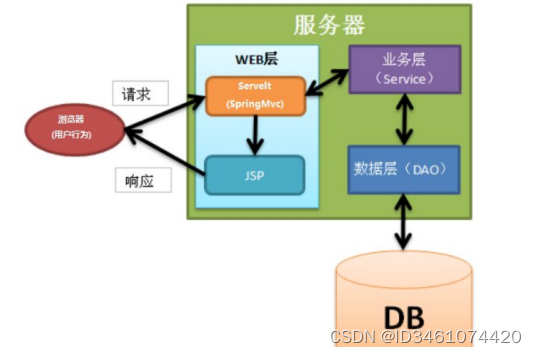
1.5 Paper structure and chapter arrangement
The paper will be organized hierarchically. In addition to the abstract, acknowledgments, and literature references, the main text will also analyze the website requirements, describe the general design and implemented functions, and finally list some debugging records. The main structure of the paper is as follows:
Chapter 1: Introduction. The first chapter mainly introduces the background of the project research, the current situation of system development and the research purpose and main work of this article.
Chapter 2: System requirements analysis. Chapter 2 mainly conducts demand analysis from the aspects of users and functions of the system.
Chapter 3: System Design. Chapter 3 mainly carries out functional design of the system framework, system function modules and database.
Chapter 4: System implementation. Chapter 4 mainly introduces the system framework construction and the implementation of the system interface.
Chapter 5: System Testing. Chapter 5 mainly tests some interfaces of the system and tests the main functions.
2 Analysis of hotel reservation management system
System analysis is a prerequisite for developing a project. Through system analysis, the basic needs of the main users of the system can be well understood, and this is also the reason for the development of the project. Then, a feasibility analysis is performed on the system development, which usually includes technical feasibility, economic feasibility, etc. The feasibility analysis is also an analysis from the overall perspective of the project. Then the specific requirements of the project are analyzed. The analysis method is generally implemented through the user's use case diagram. The following is a detailed introduction.
2.1 Feasibility analysis
Most of the tools used in the project are currently popular open source and free, so in the early stage of development, the funds used for the project will be greatly reduced, and the development of the software will not be affected by funds during the project startup period, so It is still economically feasible. Try to meet the needs of users with the least amount of money. Save money on labor costs and equipment costs. We will go further and further on the road of paperlessness and high efficiency.
So there is no problem with economic feasibility.
(2) Operational feasibility:
The design of this project refers to several cases of website development under this mode, analyzes their operation interfaces, and combines many cases to highlight people-oriented simplified operations, so people with basic computer knowledge can operate this project.
Therefore, there is no problem with operational feasibility.
(3) Technical feasibility:
Technical feasibility refers to the feasibility of building a framework, as well as the system's adaptability to technological upgrading when better technologies emerge, and the development time and cost ratio.
The existing ssm technology can cater to the construction of all e-commerce systems. When developing this hotel reservation management system, I used ssm+MYSQL to run the overall program.
In summary, there is no problem with the technical feasibility.
(4) Legal feasibility:
From a developer's perspective, ssm and MYSQL are open source and free online, and there will be no legal disputes regarding intellectual property rights.
From a user perspective, as long as contraband is no longer sold on the system, treaties and agreements are made with the system, and illegal payments are eliminated.
In summary, there is no problem with the legal feasibility.
The business process uses some specific symbols and lines to demonstrate the user's process when using the system. When performing system analysis, the business process can help developers better understand the business, discover errors, and improve the system.
After the user successfully logs in to the system , he or she can add data. The number of the added data is specific and generated by the system. The user cannot fill it in at will. Except for the number, the user fills in other added information by himself. The filled-in information is verified by the system and is legal. If it passes, it will show that the data has been added successfully. If it is passed, it will not be added successfully. Figure 2-1 shows the process of adding data.

Figure 2-1 Data addition flow chart
2.2.2 Data modification process
The process of data modification is similar to the process of data addition described above, as shown in Figure 2-2 .
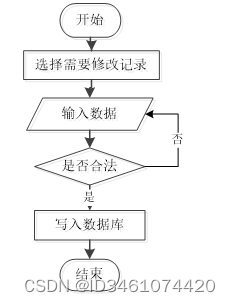
Figure 2-2 Data modification flow chart
If there is some useless data in the system , the relevant managers can also delete the data. Figure 2-3 is the flow chart for data deletion.

Figure 2-3 Data deletion flow chart
According to the roles of the hotel reservation management system, I divided it into three parts: the front desk customer service management module, the ordinary user module and the administrator management module.
Ordinary user management module:
(1) User registration and login: Visitors can enter the system at any time and browse the information in the system. However, if they want to register, they must have an account in this system. If they do not have an account, they can register as a member user to perform related operations. , at the same time, users can also control personal information and operation information through the "My Account" button.
(2) View the homepage information of the hotel reservation management system: The homepage information of the hotel reservation management system includes the homepage, hotel announcements, hotel information, hotel rooms, and mine (my account, my collection, personal center).
(3) Hotel announcements: Users can check the hotel announcement information released by the backend administrator. When they find the hotel announcement they want to know, they can enter to view the detailed introduction.
(4) Hotel information: Users can view hotel information. When they find the hotel information they want to know, they can enter and view the detailed introduction to comment, like, and collect.
(5) Hotel rooms: When the user clicks the "Hotel Rooms" menu button, all hotel room information released by the administrator in the background will be displayed. It supports searching for hotel rooms by keywords. Select the required hotel room and click to enter. Go to the detailed introduction interface of the hotel room. In the detailed interface, you can view the hotel room management number, room facilities, discounts, room name, room unit price, front desk customer service, room type, room quantity and other information. At the same time, you can make reservations, likes, Collections, comments and other operations;
(6) My Account: Click "My Account" under "My" at the front desk to manage and control personal information + password modification + your own collection of information.
Administrator management module:
(1) Login: The administrator can enter the username + password to log in in the background. The administrator's username and password are set directly in the database.
(2) Carousel image/hotel announcement management: The administrator can add, delete, modify and check the carousel image and hotel announcements displayed at the front desk of the system to facilitate user viewing.
(3) System users: The administrator can review and manage the administrators in the hotel reservation management system, as well as the front desk customer service and ordinary users registered at the front desk.
(4) Resource management: When the administrator clicks the "Resource Management" menu, the two submenus of hotel information and news classification list will be displayed. The administrator can update and maintain the functions involved in these two modules to better serve the front desk. user;
(5) Module management: Under the "Module Management" menu, we will see hotel rooms, room types, reservation information, check-in information, checkout and check-out, and the administrator can add, delete, modify and check them.
2.3.2 Non-functional analysis
The non-functional requirements of the hotel reservation management system include the security, reliability, performance, scalability, etc. of the hotel reservation management system. The details can be expressed in the following 3-1 table:
Table 3-1 Non -functional requirements table of hotel reservation management system
| safety |
Mainly refers to the installation of the hotel reservation management system database, the use of the database and the setting of passwords must comply with standards. |
| reliability |
Reliability means that the hotel reservation management system can operate according to the user's instructions. After testing, the reliability is over 90%. |
| performance |
Performance is a necessary condition for the hotel reservation management system to occupy the market, so it is best to have good performance. |
| Scalability |
For example, the database reserves multiple attributes, such as the use of interfaces, to ensure the non-functional requirements of the system. |
| Ease of use |
Users only need to follow the page display content of the hotel reservation management system and operate. |
| maintainability |
The maintainability of hotel reservation management system development is very important. After testing, there is no problem with maintainability. |
2.4 System use case analysis
Through the analysis of 2.3 functions, the use case diagram of this hotel reservation management system is obtained:
An example of a common user role is shown in Figure 2-3.
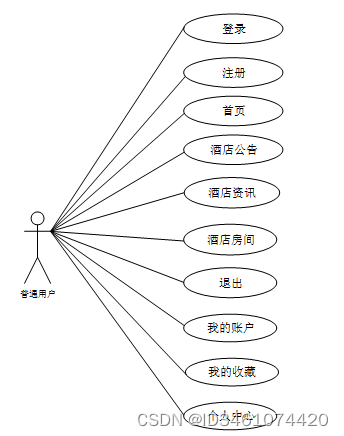
Figure 2-3 Use case diagram of ordinary user roles in the hotel reservation management system
The administrator on the web background management maintains all data information in the entire hotel reservation management system. An example of the administrator role is shown in Figure 2-4.
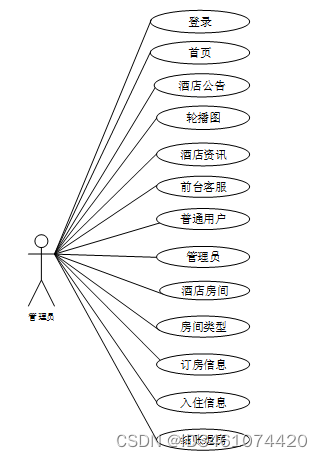
Figure 2-4 Hotel reservation management system administrator role use case diagram
This chapter mainly determines the functions to be realized by the entire hotel reservation management system through feasibility analysis, process analysis, functional requirements analysis, and system use case analysis of the hotel reservation management system. At the same time, it also provides standards for code implementation and testing of hotel reservation management systems.
3 Overall design of hotel reservation management system
The main contents discussed in this chapter include the functional module design and database system design of the hotel reservation management system.
3.1 System architecture design
This hotel reservation management system is divided into three layers in terms of architecture: presentation layer (UI), business logic layer (BLL) and data layer (DL).
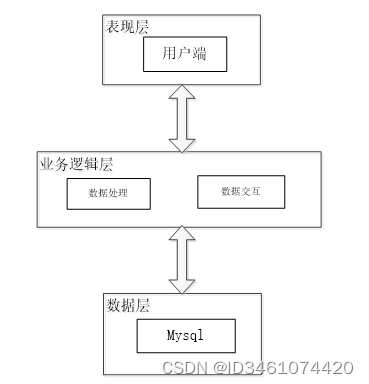
Figure 3-1 System architecture design diagram of hotel reservation management system
Presentation layer (UI): Also known as the UI layer, it mainly completes the UI interaction function of the hotel reservation management system. A good UI can improve the user experience and enhance the user's comfort when using the hotel reservation management system. The UI interface design must also adapt to different versions of hotel reservation management systems and different size resolutions to achieve good compatibility. The UI interaction function requirements are reasonable, and users must obtain consistent interaction results when performing interactive operations. This requires the presentation layer to be well connected with the business logic layer.
Business logic layer (BLL): mainly completes the data processing function of the hotel reservation management system. The data transmitted by the user from the presentation layer is processed by the business logic layer and delivered to the data layer. The data read by the system from the data layer is processed by the business logic layer and delivered to the presentation layer.
Data layer (DL): Since the data of this hotel reservation management system is placed in the mysql database on the server side, the part that belongs to the service layer can be directly integrated into the business logic layer, so there is only a database in the data layer, which mainly completes this task. Data storage and management functions of hotel reservation management system.
3.2 System function module design
3.2.1 Overall functional module design
In the previous chapter, the functional requirements and non-functional requirements of the system were mainly analyzed, and the use cases in the hotel reservation management system were analyzed based on the requirements. Then the next step is to start designing the architecture, main functions and database of the hotel reservation management system. The hotel reservation management system is derived based on the demand analysis in the previous chapter. Its overall design module diagram is shown in Figure 3-2.
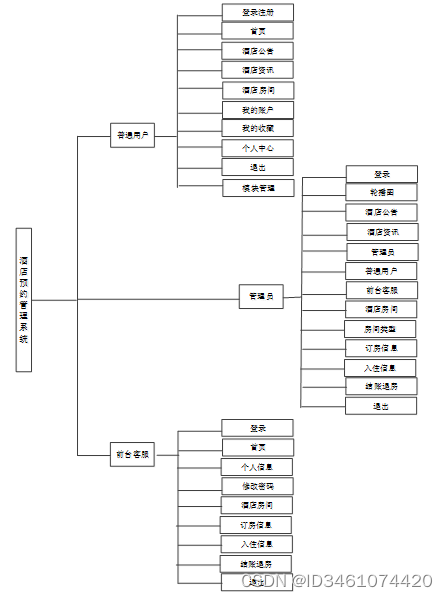
Figure 3-2 Function module diagram of hotel reservation management system
3.2.2 User module design
The backend manager can add, delete, modify and check the users registered in the frontend. The user module structure diagram is as follows:

Figure 3-3 User module structure diagram
3.2.3 Comment management module design
The hotel reservation management system is an open platform for communication. Users and managers can comment on the information on the platform to increase the interaction between users. But at the same time, in order to better standardize the content of comments and give administrators the function of deleting inappropriate comments, a comment management module needs to be specially designed. The specific structure diagram is as follows:

Figure 3-4 Structure diagram of comment module
Database design generally includes three major processes: demand analysis, conceptual model design, and database table creation. The demand analysis has been explained in the previous chapter, and the conceptual model design has two parts: conceptual model and logical structure design.
3.3.1 Database conceptual structure design
The following is the total ER entity relationship diagram of the main database tables in the entire hotel reservation management system.

Figure 3-6 Overall ER relationship diagram of hotel reservation management system
3.3.2 Database logical structure design
Table check_in_information (check-in information)
| serial number |
name |
type of data |
length |
Decimal places |
Allow null values |
primary key |
default value |
illustrate |
| 1 |
check_in_information_id |
int |
10 |
0 |
N |
Y |
Check-in information ID |
|
| 2 |
order_number |
varchar |
64 |
0 |
N |
N |
order number |
|
| 3 |
management_no |
varchar |
64 |
0 |
Y |
N |
Management number |
|
| 4 |
room_name |
varchar |
64 |
0 |
Y |
N |
Room name |
|
| 5 |
room_type |
varchar |
64 |
0 |
Y |
N |
Room type |
|
| 6 |
room_facilities |
varchar |
64 |
0 |
Y |
N |
Room facilities |
|
| 7 |
front_desk_customer_service |
int |
10 |
0 |
Y |
N |
0 |
Front desk customer service |
| 8 |
room_unit_price |
int |
10 |
0 |
Y |
N |
0 |
Room unit price |
| 9 |
discount |
varchar |
64 |
0 |
Y |
N |
Discount |
|
| 10 |
booking_users |
int |
10 |
0 |
Y |
N |
0 |
Booking users |
| 11 |
number_of_room_reservations |
int |
10 |
0 |
Y |
N |
0 |
Number of rooms booked |
| 12 |
date_of_check_in |
date |
10 |
0 |
Y |
N |
Check-in date |
|
| 13 |
recommend |
int |
10 |
0 |
N |
N |
0 |
Intelligent Recommendation |
| 14 |
create_time |
datetime |
19 |
0 |
N |
N |
CURRENT_TIMESTAMP |
creation time |
| 15 |
update_time |
timestamp |
19 |
0 |
N |
N |
CURRENT_TIMESTAMP |
Update time |
Table check_out (checkout)
| serial number |
name |
type of data |
length |
Decimal places |
Allow null values |
primary key |
default value |
illustrate |
| 1 |
check_out_id |
int |
10 |
0 |
N |
Y |
Checkout ID |
|
| 2 |
order_number |
varchar |
64 |
0 |
N |
N |
order number |
|
| 3 |
management_no |
varchar |
64 |
0 |
Y |
N |
Management number |
|
| 4 |
room_name |
varchar |
64 |
0 |
Y |
N |
Room name |
|
| 5 |
room_type |
varchar |
64 |
0 |
Y |
N |
Room type |
|
| 6 |
room_facilities |
varchar |
64 |
0 |
Y |
N |
Room facilities |
|
| 7 |
front_desk_customer_service |
int |
10 |
0 |
Y |
N |
0 |
Front desk customer service |
| 8 |
discount |
varchar |
64 |
0 |
Y |
N |
Discount |
|
| 9 |
room_unit_price |
int |
10 |
0 |
Y |
N |
0 |
Room unit price |
| 10 |
booking_users |
int |
10 |
0 |
Y |
N |
0 |
Booking users |
| 11 |
number_of_room_reservations |
int |
10 |
0 |
Y |
N |
0 |
Number of rooms booked |
| 12 |
date_of_check_in |
date |
10 |
0 |
Y |
N |
Check-in date |
|
| 13 |
check_out |
date |
10 |
0 |
Y |
N |
Check out date |
|
| 14 |
number_of_check_in_days |
int |
10 |
0 |
Y |
N |
0 |
Number of days staying |
| 15 |
payment_amount |
varchar |
64 |
0 |
Y |
N |
Payment amount |
|
| 16 |
pay_state |
varchar |
16 |
0 |
N |
N |
unpaid |
Payment status |
| 17 |
pay_type |
varchar |
16 |
0 |
Y |
N |
Payment type: WeChat, Alipay, online banking |
|
| 18 |
recommend |
int |
10 |
0 |
N |
N |
0 |
Intelligent Recommendation |
| 19 |
create_time |
datetime |
19 |
0 |
N |
N |
CURRENT_TIMESTAMP |
creation time |
| 20 |
update_time |
timestamp |
19 |
0 |
N |
N |
CURRENT_TIMESTAMP |
Update time |
table collect (collection)
| serial number |
name |
type of data |
length |
Decimal places |
Allow null values |
primary key |
default value |
illustrate |
| 1 |
collect_id |
int |
10 |
0 |
N |
Y |
Collection ID: |
|
| 2 |
user_id |
int |
10 |
0 |
N |
N |
0 |
Collector ID: |
| 3 |
source_table |
varchar |
255 |
0 |
Y |
N |
Source table: |
|
| 4 |
source_field |
varchar |
255 |
0 |
Y |
N |
Source field: |
|
| 5 |
source_id |
int |
10 |
0 |
N |
N |
0 |
Source ID: |
| 6 |
title |
varchar |
255 |
0 |
Y |
N |
title: |
|
| 7 |
img |
varchar |
255 |
0 |
Y |
N |
Cover: |
|
| 8 |
create_time |
timestamp |
19 |
0 |
N |
N |
CURRENT_TIMESTAMP |
Creation time: |
| 9 |
update_time |
timestamp |
19 |
0 |
N |
N |
CURRENT_TIMESTAMP |
Update time: |
Table comment (comment)
| serial number |
name |
type of data |
length |
Decimal places |
Allow null values |
primary key |
default value |
illustrate |
| 1 |
comment_id |
int |
10 |
0 |
N |
Y |
Comment ID: |
|
| 2 |
user_id |
int |
10 |
0 |
N |
N |
0 |
Commenter ID: |
| 3 |
reply_to_id |
int |
10 |
0 |
N |
N |
0 |
Reply comment ID: empty is 0 |
| 4 |
content |
longtext |
2147483647 |
0 |
Y |
N |
content: |
|
| 5 |
nickname |
varchar |
255 |
0 |
Y |
N |
Nick name: |
|
| 6 |
avatar |
varchar |
255 |
0 |
Y |
N |
Avatar address: [0,255] |
|
| 7 |
create_time |
timestamp |
19 |
0 |
N |
N |
CURRENT_TIMESTAMP |
Creation time: |
| 8 |
update_time |
timestamp |
19 |
0 |
N |
N |
CURRENT_TIMESTAMP |
Update time: |
| 9 |
source_table |
varchar |
255 |
0 |
Y |
N |
Source table: |
|
| 10 |
source_field |
varchar |
255 |
0 |
Y |
N |
Source field: |
|
| 11 |
source_id |
int |
10 |
0 |
N |
N |
0 |
Source ID: |
Table front_desk_customer_service (front desk customer service)
| serial number |
name |
type of data |
length |
Decimal places |
Allow null values |
primary key |
default value |
illustrate |
| 1 |
front_desk_customer_service_id |
int |
10 |
0 |
N |
Y |
前台客服ID |
|
| 2 |
customer_service_id |
varchar |
64 |
0 |
N |
N |
客服工号 |
|
| 3 |
customer_service_name |
varchar |
64 |
0 |
Y |
N |
客服姓名 |
|
| 4 |
examine_state |
varchar |
16 |
0 |
N |
N |
已通过 |
审核状态 |
| 5 |
recommend |
int |
10 |
0 |
N |
N |
0 |
智能推荐 |
| 6 |
user_id |
int |
10 |
0 |
N |
N |
0 |
用户ID |
| 7 |
create_time |
datetime |
19 |
0 |
N |
N |
CURRENT_TIMESTAMP |
创建时间 |
| 8 |
update_time |
timestamp |
19 |
0 |
N |
N |
CURRENT_TIMESTAMP |
更新时间 |
表hits (用户点击)
| 编号 |
名称 |
数据类型 |
长度 |
小数位 |
允许空值 |
主键 |
默认值 |
说明 |
| 1 |
hits_id |
int |
10 |
0 |
N |
Y |
点赞ID: |
|
| 2 |
user_id |
int |
10 |
0 |
N |
N |
0 |
点赞人: |
| 3 |
create_time |
timestamp |
19 |
0 |
N |
N |
CURRENT_TIMESTAMP |
创建时间: |
| 4 |
update_time |
timestamp |
19 |
0 |
N |
N |
CURRENT_TIMESTAMP |
更新时间: |
| 5 |
source_table |
varchar |
255 |
0 |
Y |
N |
来源表: |
|
| 6 |
source_field |
varchar |
255 |
0 |
Y |
N |
来源字段: |
|
| 7 |
source_id |
int |
10 |
0 |
N |
N |
0 |
来源ID: |
表hotel_room (酒店房间)
| 编号 |
名称 |
数据类型 |
长度 |
小数位 |
允许空值 |
主键 |
默认值 |
说明 |
| 1 |
hotel_room_id |
int |
10 |
0 |
N |
Y |
酒店房间ID |
|
| 2 |
management_no |
varchar |
64 |
0 |
N |
N |
管理编号 |
|
| 3 |
cover |
varchar |
255 |
0 |
Y |
N |
封面 |
|
| 4 |
room_name |
varchar |
64 |
0 |
Y |
N |
房间名称 |
|
| 5 |
room_type |
varchar |
64 |
0 |
Y |
N |
房间类型 |
|
| 6 |
room_facilities |
varchar |
64 |
0 |
Y |
N |
房间设施 |
|
| 7 |
room_unit_price |
int |
10 |
0 |
Y |
N |
0 |
房间单价 |
| 8 |
number_of_rooms |
int |
10 |
0 |
Y |
N |
0 |
房间数量 |
| 9 |
discount |
varchar |
64 |
0 |
Y |
N |
折扣 |
|
| 10 |
front_desk_customer_service |
int |
10 |
0 |
Y |
N |
0 |
前台客服 |
| 11 |
room_details |
longtext |
2147483647 |
0 |
Y |
N |
房间详情 |
|
| 12 |
hits |
int |
10 |
0 |
N |
N |
0 |
点击数 |
| 13 |
praise_len |
int |
10 |
0 |
N |
N |
0 |
点赞数 |
| 14 |
recommend |
int |
10 |
0 |
N |
N |
0 |
智能推荐 |
| 15 |
create_time |
datetime |
19 |
0 |
N |
N |
CURRENT_TIMESTAMP |
创建时间 |
| 16 |
update_time |
timestamp |
19 |
0 |
N |
N |
CURRENT_TIMESTAMP |
更新时间 |
表notice (公告)
| 编号 |
名称 |
数据类型 |
长度 |
小数位 |
允许空值 |
主键 |
默认值 |
说明 |
| 1 |
notice_id |
mediumint |
8 |
0 |
N |
Y |
公告id: |
|
| 2 |
title |
varchar |
125 |
0 |
N |
N |
标题: |
|
| 3 |
content |
longtext |
2147483647 |
0 |
Y |
N |
正文: |
|
| 4 |
create_time |
timestamp |
19 |
0 |
N |
N |
CURRENT_TIMESTAMP |
创建时间: |
| 5 |
update_time |
timestamp |
19 |
0 |
N |
N |
CURRENT_TIMESTAMP |
更新时间: |
表ordinary_users (普通用户)
| 编号 |
名称 |
数据类型 |
长度 |
小数位 |
允许空值 |
主键 |
默认值 |
说明 |
| 1 |
ordinary_users_id |
int |
10 |
0 |
N |
Y |
普通用户ID |
|
| 2 |
user_name |
varchar |
64 |
0 |
Y |
N |
用户姓名 |
|
| 3 |
user_gender |
varchar |
64 |
0 |
Y |
N |
用户性别 |
|
| 4 |
examine_state |
varchar |
16 |
0 |
N |
N |
已通过 |
审核状态 |
| 5 |
recommend |
int |
10 |
0 |
N |
N |
0 |
智能推荐 |
| 6 |
user_id |
int |
10 |
0 |
N |
N |
0 |
用户ID |
| 7 |
create_time |
datetime |
19 |
0 |
N |
N |
CURRENT_TIMESTAMP |
创建时间 |
| 8 |
update_time |
timestamp |
19 |
0 |
N |
N |
CURRENT_TIMESTAMP |
更新时间 |
表praise (点赞)
| 编号 |
名称 |
数据类型 |
长度 |
小数位 |
允许空值 |
主键 |
默认值 |
说明 |
| 1 |
praise_id |
int |
10 |
0 |
N |
Y |
点赞ID: |
|
| 2 |
user_id |
int |
10 |
0 |
N |
N |
0 |
点赞人: |
| 3 |
create_time |
timestamp |
19 |
0 |
N |
N |
CURRENT_TIMESTAMP |
创建时间: |
| 4 |
update_time |
timestamp |
19 |
0 |
N |
N |
CURRENT_TIMESTAMP |
更新时间: |
| 5 |
source_table |
varchar |
255 |
0 |
Y |
N |
来源表: |
|
| 6 |
source_field |
varchar |
255 |
0 |
Y |
N |
来源字段: |
|
| 7 |
source_id |
int |
10 |
0 |
N |
N |
0 |
来源ID: |
| 8 |
status |
bit |
1 |
0 |
N |
N |
1 |
点赞状态:1为点赞,0已取消 |
表reservation_information (订房信息)
| 编号 |
名称 |
数据类型 |
长度 |
小数位 |
允许空值 |
主键 |
默认值 |
说明 |
| 1 |
reservation_information_id |
int |
10 |
0 |
N |
Y |
订房信息ID |
|
| 2 |
order_number |
varchar |
64 |
0 |
Y |
N |
订单号 |
|
| 3 |
management_no |
varchar |
64 |
0 |
Y |
N |
管理编号 |
|
| 4 |
room_name |
varchar |
64 |
0 |
Y |
N |
房间名称 |
|
| 5 |
room_type |
varchar |
64 |
0 |
Y |
N |
房间类型 |
|
| 6 |
room_facilities |
varchar |
64 |
0 |
Y |
N |
房间设施 |
|
| 7 |
front_desk_customer_service |
int |
10 |
0 |
Y |
N |
0 |
前台客服 |
| 8 |
room_unit_price |
int |
10 |
0 |
Y |
N |
0 |
房间单价 |
| 9 |
discount |
varchar |
64 |
0 |
Y |
N |
折扣 |
|
| 10 |
reservation_date |
date |
10 |
0 |
Y |
N |
订房日期 |
|
| 11 |
booking_users |
int |
10 |
0 |
Y |
N |
0 |
订房用户 |
| 12 |
number_of_room_reservations |
int |
10 |
0 |
Y |
N |
0 |
订房数量 |
| 13 |
remarks |
varchar |
64 |
0 |
Y |
N |
备注 |
|
| 14 |
examine_state |
varchar |
16 |
0 |
N |
N |
未审核 |
审核状态 |
| 15 |
examine_reply |
varchar |
16 |
0 |
Y |
N |
审核回复 |
|
| 16 |
recommend |
int |
10 |
0 |
N |
N |
0 |
智能推荐 |
| 17 |
create_time |
datetime |
19 |
0 |
N |
N |
CURRENT_TIMESTAMP |
创建时间 |
| 18 |
update_time |
timestamp |
19 |
0 |
N |
N |
CURRENT_TIMESTAMP |
更新时间 |
表room_type (房间类型)
| 编号 |
名称 |
数据类型 |
长度 |
小数位 |
允许空值 |
主键 |
默认值 |
说明 |
| 1 |
room_type_id |
int |
10 |
0 |
N |
Y |
房间类型ID |
|
| 2 |
room_type |
varchar |
64 |
0 |
Y |
N |
房间类型 |
|
| 3 |
recommend |
int |
10 |
0 |
N |
N |
0 |
智能推荐 |
| 4 |
create_time |
datetime |
19 |
0 |
N |
N |
CURRENT_TIMESTAMP |
创建时间 |
| 5 |
update_time |
timestamp |
19 |
0 |
N |
N |
CURRENT_TIMESTAMP |
更新时间 |
表slides (轮播图)
| 编号 |
名称 |
数据类型 |
长度 |
小数位 |
允许空值 |
主键 |
默认值 |
说明 |
| 1 |
slides_id |
int |
10 |
0 |
N |
Y |
轮播图ID: |
|
| 2 |
title |
varchar |
64 |
0 |
Y |
N |
标题: |
|
| 3 |
content |
varchar |
255 |
0 |
Y |
N |
内容: |
|
| 4 |
url |
varchar |
255 |
0 |
Y |
N |
链接: |
|
| 5 |
img |
varchar |
255 |
0 |
Y |
N |
轮播图: |
|
| 6 |
hits |
int |
10 |
0 |
N |
N |
0 |
点击量: |
| 7 |
create_time |
timestamp |
19 |
0 |
N |
N |
CURRENT_TIMESTAMP |
创建时间: |
| 8 |
update_time |
timestamp |
19 |
0 |
N |
N |
CURRENT_TIMESTAMP |
更新时间: |
表upload (文件上传)
| 编号 |
名称 |
数据类型 |
长度 |
小数位 |
允许空值 |
主键 |
默认值 |
说明 |
| 1 |
upload_id |
int |
10 |
0 |
N |
Y |
上传ID |
|
| 2 |
name |
varchar |
64 |
0 |
Y |
N |
文件名 |
|
| 3 |
path |
varchar |
255 |
0 |
Y |
N |
访问路径 |
|
| 4 |
file |
varchar |
255 |
0 |
Y |
N |
文件路径 |
|
| 5 |
display |
varchar |
255 |
0 |
Y |
N |
显示顺序 |
|
| 6 |
father_id |
int |
10 |
0 |
Y |
N |
0 |
父级ID |
| 7 |
dir |
varchar |
255 |
0 |
Y |
N |
文件夹 |
|
| 8 |
type |
varchar |
32 |
0 |
Y |
N |
文件类型 |
表user (用户账户:用于保存用户登录信息)
| 编号 |
名称 |
数据类型 |
长度 |
小数位 |
允许空值 |
主键 |
默认值 |
说明 |
| 1 |
user_id |
mediumint |
8 |
0 |
N |
Y |
用户ID:[0,8388607]用户获取其他与用户相关的数据 |
|
| 2 |
state |
smallint |
5 |
0 |
N |
N |
1 |
账户状态:[0,10](1可用|2异常|3已冻结|4已注销) |
| 3 |
user_group |
varchar |
32 |
0 |
Y |
N |
所在用户组:[0,32767]决定用户身份和权限 |
|
| 4 |
login_time |
timestamp |
19 |
0 |
N |
N |
CURRENT_TIMESTAMP |
上次登录时间: |
| 5 |
phone |
varchar |
11 |
0 |
Y |
N |
手机号码:[0,11]用户的手机号码,用于找回密码时或登录时 |
|
| 6 |
phone_state |
smallint |
5 |
0 |
N |
N |
0 |
手机认证:[0,1](0未认证|1审核中|2已认证) |
| 7 |
username |
varchar |
16 |
0 |
N |
N |
用户名:[0,16]用户登录时所用的账户名称 |
|
| 8 |
nickname |
varchar |
16 |
0 |
Y |
N |
昵称:[0,16] |
|
| 9 |
password |
varchar |
64 |
0 |
N |
N |
密码:[0,32]用户登录所需的密码,由6-16位数字或英文组成 |
|
| 10 |
|
varchar |
64 |
0 |
Y |
N |
邮箱:[0,64]用户的邮箱,用于找回密码时或登录时 |
|
| 11 |
email_state |
smallint |
5 |
0 |
N |
N |
0 |
邮箱认证:[0,1](0未认证|1审核中|2已认证) |
| 12 |
avatar |
varchar |
255 |
0 |
Y |
N |
头像地址:[0,255] |
|
| 13 |
create_time |
timestamp |
19 |
0 |
N |
N |
CURRENT_TIMESTAMP |
创建时间: |
表user_group (用户组:用于用户前端身份和鉴权)
| 编号 |
名称 |
数据类型 |
长度 |
小数位 |
允许空值 |
主键 |
默认值 |
说明 |
| 1 |
group_id |
mediumint |
8 |
0 |
N |
Y |
用户组ID:[0,8388607] |
|
| 2 |
display |
smallint |
5 |
0 |
N |
N |
100 |
显示顺序:[0,1000] |
| 3 |
name |
varchar |
16 |
0 |
N |
N |
名称:[0,16] |
|
| 4 |
description |
varchar |
255 |
0 |
Y |
N |
描述:[0,255]描述该用户组的特点或权限范围 |
|
| 5 |
source_table |
varchar |
255 |
0 |
Y |
N |
来源表: |
|
| 6 |
source_field |
varchar |
255 |
0 |
Y |
N |
来源字段: |
|
| 7 |
source_id |
int |
10 |
0 |
N |
N |
0 |
来源ID: |
| 8 |
register |
smallint |
5 |
0 |
Y |
N |
0 |
注册位置: |
| 9 |
create_time |
timestamp |
19 |
0 |
N |
N |
CURRENT_TIMESTAMP |
创建时间: |
| 10 |
update_time |
timestamp |
19 |
0 |
N |
N |
CURRENT_TIMESTAMP |
更新时间: |
3.4本章小结
整个酒店预约管理系统的需求分析主要对系统总体架构以及功能模块的设计,通过建立E-R模型和数据库逻辑系统设计完成了数据库系统设计。
4 酒店预约管理系统详细设计与实现
酒店预约管理系统的详细设计与实现主要是根据前面的酒店预约管理系统的需求分析和酒店预约管理系统的总体设计来设计页面并实现业务逻辑。主要从酒店预约管理系统界面实现、业务逻辑实现这两部分进行介绍。
4.1用户功能模块
4.1.1 前台首页界面
当进入酒店预约管理系统的时候,首先映入眼帘的是系统的导航栏,下面是轮播图以及系统内容,其主界面展示如下图4-1所示。
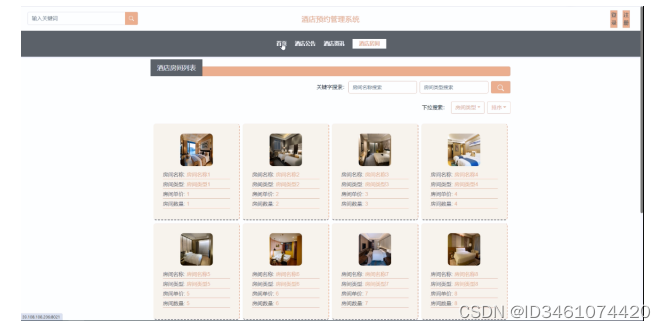
图4-1 前台首页界面图
4.1.2用户登录界面
酒店预约管理系统中的前台上注册后的用户是可以通过自己的账户名和密码进行登录的,当用户输入完整的自己的账户名和密码信息并点击“登录”按钮后,将会首先验证输入的有没有空数据,再次验证输入的账户名+密码和数据库中当前保存的用户信息是否一致,只有在一致后将会登录成功并自动跳转到酒店预约管理系统的首页中;否则将会提示相应错误信息,用户登录界面如下图4-2所示。
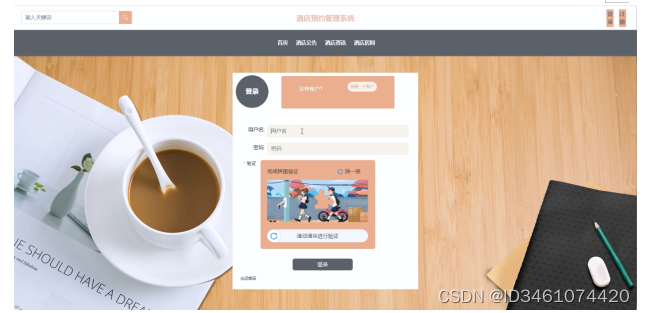
图4-2用户登录界面图
登录关键代码如下所示。
/**
* 登录
* @param data
* @param httpServletRequest
* @return
*/
@PostMapping("login")
public Map<String, Object> login(@RequestBody Map<String, String> data, HttpServletRequest httpServletRequest) {
log.info("[执行登录接口]");
String username = data.get("username");
String email = data.get("email");
String phone = data.get("phone");
String password = data.get("password");
List resultList = null;
QueryWrapper wrapper = new QueryWrapper<User>();
Map<String, String> map = new HashMap<>();
if(username != null && "".equals(username) == false){
map.put("username", username);
resultList = service.selectBaseList(service.select(map, new HashMap<>()));
}
else if(email != null && "".equals(email) == false){
map.put("email", email);
resultList = service.selectBaseList(service.select(map, new HashMap<>()));
}
else if(phone != null && "".equals(phone) == false){
map.put("phone", phone);
resultList = service.selectBaseList(service.select(map, new HashMap<>()));
}else{
return error(30000, "账号或密码不能为空");
}
if (resultList == null || password == null) {
return error(30000, "账号或密码不能为空");
}
//判断是否有这个用户
if (resultList.size()<=0){
return error(30000,"用户不存在");
}
User byUsername = (User) resultList.get(0);
Map<String, String> groupMap = new HashMap<>();
groupMap.put("name",byUsername.getUserGroup());
List groupList = userGroupService.selectBaseList(userGroupService.select(groupMap, new HashMap<>()));
if (groupList.size()<1){
return error(30000,"用户组不存在");
}
UserGroup userGroup = (UserGroup) groupList.get(0);
//查询用户审核状态
if (!StringUtils.isEmpty(userGroup.getSourceTable())){
String res = service.selectExamineState(userGroup.getSourceTable(),byUsername.getUserId());
if (res==null){
return error(30000,"用户不存在");
}
if (!res.equals("已通过")){
return error(30000,"该用户审核未通过");
}
}
//查询用户状态
if (byUsername.getState()!=1){
return error(30000,"用户非可用状态,不能登录");
}
String md5password = service.encryption(password);
if (byUsername.getPassword().equals(md5password)) {
// 存储Token到数据库
AccessToken accessToken = new AccessToken();
accessToken.setToken(UUID.randomUUID().toString().replaceAll("-", ""));
accessToken.setUser_id(byUsername.getUserId());
tokenService.save(accessToken);
// 返回用户信息
JSONObject user = JSONObject.parseObject(JSONObject.toJSONString(byUsername));
user.put("token", accessToken.getToken());
JSONObject ret = new JSONObject();
ret.put("obj",user);
return success(ret);
} else {
return error(30000, "账号或密码不正确");
}
}
public String select(Map<String,String> query,Map<String,String> config){
StringBuffer sql = new StringBuffer("select ");
sql.append(config.get(FindConfig.FIELD) == null || "".equals(config.get(FindConfig.FIELD)) ? "*" : config.get(FindConfig.FIELD)).append(" ");
sql.append("from ").append("`").append(table).append("`").append(toWhereSql(query, "0".equals(config.get(FindConfig.LIKE))));
if (config.get(FindConfig.GROUP_BY) != null && !"".equals(config.get(FindConfig.GROUP_BY))){
sql.append("group by ").append(config.get(FindConfig.GROUP_BY)).append(" ");
}
if (config.get(FindConfig.ORDER_BY) != null && !"".equals(config.get(FindConfig.ORDER_BY))){
sql.append("order by ").append(config.get(FindConfig.ORDER_BY)).append(" ");
}
if (config.get(FindConfig.PAGE) != null && !"".equals(config.get(FindConfig.PAGE))){
int page = config.get(FindConfig.PAGE) != null && !"".equals(config.get(FindConfig.PAGE)) ? Integer.parseInt(config.get(FindConfig.PAGE)) : 1;
int limit = config.get(FindConfig.SIZE) != null && !"".equals(config.get(FindConfig.SIZE)) ? Integer.parseInt(config.get(FindConfig.SIZE)) : 10;
sql.append(" limit ").append( (page-1)*limit ).append(" , ").append(limit);
}
log.info("[{}] - 查询操作,sql: {}",table,sql);
return sql.toString();
}
public List selectBaseList(String select) {
List<Map<String,Object>> mapList = baseMapper.selectBaseList(select);
List<E> list = new ArrayList<>();
for (Map<String,Object> map:mapList) {
list.add(JSON.parseObject(JSON.toJSONString(map),eClass));
}
return list;
}
4.1.3用户注册界面
不是酒店预约管理系统中正式用户的是可以在线进行注册的,如果你没有本酒店预约管理系统的账号的话,添加“注册”,当填写上自己的账号+密码+确认密码+昵称+邮箱+手机号等后再点击“注册”按钮后将会先验证输入的有没有空数据,再次验证密码和确认密码是否是一样的,最后验证输入的账户名和数据库表中已经注册的账户名是否重复,只有都验证没问题后即可用户注册成功。其用用户注册界面展示如下图4-3所示。
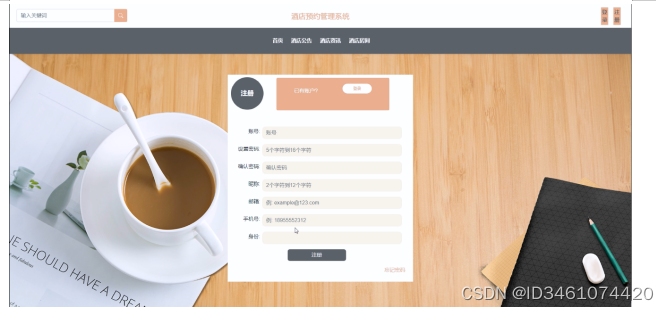
图4-2用户注册界面图
注册关键代码如下所示。
/**
* 注册
* @return
*/
@PostMapping("register")
public Map<String, Object> signUp(HttpServletRequest request) throws IOException {
// 查询用户
Map<String, String> query = new HashMap<>();
Map<String,Object> map = service.readBody(request.getReader());
query.put("username",String.valueOf(map.get("username")));
List list = service.selectBaseList(service.select(query, new HashMap<>()));
if (list.size()>0){
return error(30000, "用户已存在");
}
map.put("password",service.encryption(String.valueOf(map.get("password"))));
service.insert(map);
return success(1);
}
public Map<String,Object> readBody(BufferedReader reader){
BufferedReader br = null;
StringBuilder sb = new StringBuilder("");
try{
br = reader;
String str;
while ((str = br.readLine()) != null){
sb.append(str);
}
br.close();
String json = sb.toString();
return JSONObject.parseObject(json, Map.class);
}catch (IOException e){
e.printStackTrace();
}finally{
if (null != br){
try{
br.close();
}catch (IOException e){
e.printStackTrace();
}
}
}
return null;
}
public void insert(Map<String,Object> body){
E entity = JSON.parseObject(JSON.toJSONString(body),eClass);
baseMapper.insert(entity);
log.info("[{}] - 插入操作:{}",entity);
}
4.1.4酒店公告界面
当点击导航栏上的“酒店公告”的时候,就会进入对应的界面查看公告信息,酒店公告界面如下图4-4所示。

图4-4酒店公告界面图
当用户点击“酒店房间”这一菜单按钮,会显示管理员在后台发布的所有的酒店房间信息,支持通过关键词对酒店房间进行搜索,选择需要的酒店房间点击可以进入到酒店房间详细的介绍界面,在详细界面可以查看到酒店房间的管理编号、房间设施、折扣、房间名称、房间单价、前台客服、房间类型、房间数量等信息,同时可以进行订房、点赞、收藏、评论等操作,酒店房间详情界面如下图4-5所示。

图4-5酒店房间详情界面图
4.1.6酒店资讯界面
当访客点击酒店预约管理系统中导航栏上的“酒店资讯”后将会进入到该“酒店资讯”列表的界面,然后选择想要看的酒店资讯信息,点击进入到详细界面,在详细界面可以收藏+赞+评论等操作,酒店资讯界面如下图4-6所示。
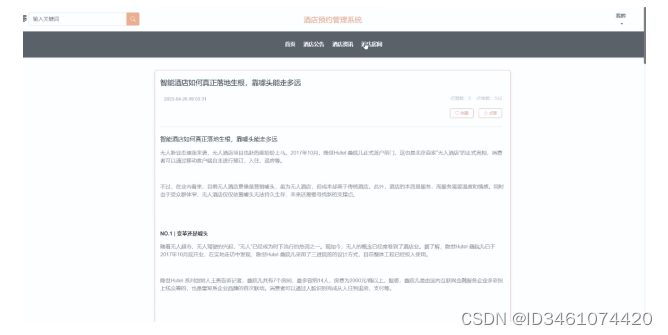
图4-6酒店资讯界面图
4.1.7我的账户界面
当用户点击右上角“我的”这个按钮,会出现子菜单,点击“我的账户”可以对个人的资料、登录系统的密码以及自己收藏的信息进行设置管理,我的账户界面如下图4-7所示。
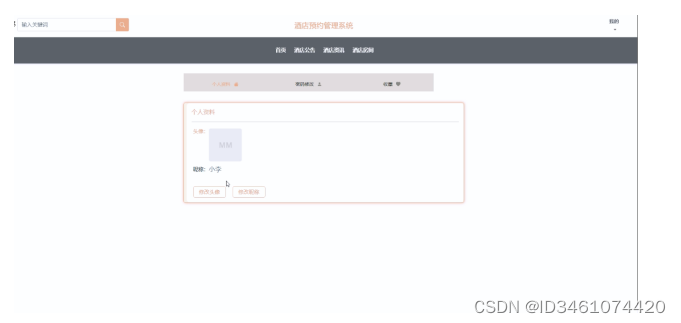
图4-7我的账户界面图
4.2管理员功能模块
酒店预约管理系统的理员拥有最高的权限,可以对用户信息、系统信息以及酒店预约管理系统相关信息进行管控。
管理员在后台可以通过账号和密码进行登录,管理员的账号和密码是在数据库中直接设定的。界面展示如下图4-8所示。
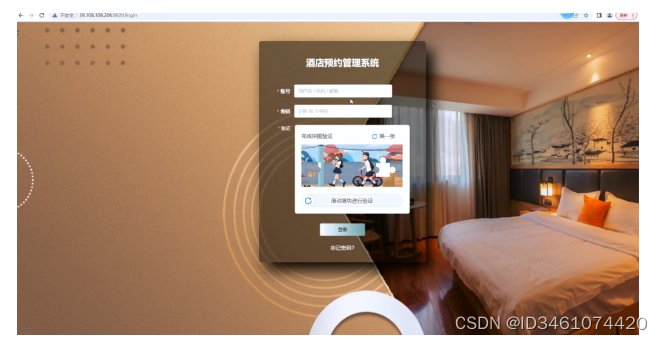
图4-8登录界面图
管理员点击“系统用户”这一菜单会显示管理员、前台客服、普通用户这三个子菜单,管理员可以对这三个角色的信息进行增删改查操作。界面如下图4-9所示。

图4-9系统用户管理界面图
系统用户管理关键代码如下所示。
public List selectBaseList(String select) {
List<Map<String,Object>> mapList = baseMapper.selectBaseList(select);
List<E> list = new ArrayList<>();
for (Map<String,Object> map:mapList) {
list.add(JSON.parseObject(JSON.toJSONString(map),eClass));
}
return list;
}
4.2.3酒店公告管理界面
酒店预约管理系统中的管理人员在“酒店公告管理”这一菜单中是可以对前台显示的酒店公告进行管控。界面如下图4-10所示。

图4-10酒店公告管理界面图
资源管理主要管理员是对酒店资讯以及新闻所属的分类进行管控,包含了用户对酒店资讯提交的评论信息,界面如下图4-11所示。

图4-11资源管理界面图
酒店预约管理系统中的管理人员在“模块管理”这一菜单下是可以对酒店预约管理系统内的酒店房间、房间类型、订房信息、入住信息、结账退房进行管控的,其管理界面如下图4-12所示。

模块管理关键代码如下所示。
@RequestMapping("/get_obj")
public Map<String, Object> obj(HttpServletRequest request) {
List resultList = service.selectBaseList(service.select(service.readQuery(request), service.readConfig(request)));
if (resultList.size() > 0) {
JSONObject jsonObject = new JSONObject();
jsonObject.put("obj",resultList.get(0));
return success(jsonObject);
} else {
return success(null);
}
}
5系统测试
系统开发到了最后一个阶段那就是系统测试,系统测试对软件的开发其实是非常有必要的。因为没什么系统一经开发出来就可能会尽善尽美,再厉害的系统开发工程师也会在系统开发的时候出现纰漏,系统测试能够较好的改正一些bug,为后期系统的维护性提供很好的支持。通过系统测试,开发人员也可以建立自己对系统的信心,为后期的系统版本的跟新提供支持。
系统测试包括:用户登录功能测试、酒店房间展示功能测试、酒店房间添加、酒店房间搜索、密码修改功能测试,如表5-1、5-2、5-3、5-4、5-5所示:
表5-1 用户登录功能测试表
| 用例名称 |
用户登录系统 |
| 目的 |
测试用户通过正确的用户名和密码可否登录功能 |
| 前提 |
未登录的情况下 |
| 测试流程 |
1) 进入登录页面 2) 输入正确的用户名和密码 |
| 预期结果 |
用户名和密码正确的时候,跳转到登录成功界面,反之则显示错误信息,提示重新输入 |
| 实际结果 |
实际结果与预期结果一致 |
酒店房间查看功能测试:
表5-2 酒店房间查看功能测试表
| 用例名称 |
酒店房间查看 |
| 目的 |
测试酒店房间查看功能 |
| 前提 |
用户登录 |
| 测试流程 |
点击酒店房间列表 |
| 预期结果 |
可以查看到所有酒店房间信息 |
| 实际结果 |
实际结果与预期结果一致 |
管理员添加酒店房间界面测试:
表5-3 管理员添加酒店房间界面测试表
| 用例名称 |
酒店房间发布测试用例 |
| 目的 |
测试酒店房间发布功能 |
| 前提 |
用户正常登录情况下 |
| 测试流程 |
1)点击酒店房间信息管理就,然后点击添加后并填写信息。 2)点击进行提交。 |
| 预期结果 |
提交以后,页面首页会显示新的酒店房间信息 |
| 实际结果 |
实际结果与预期结果一致 |
酒店房间搜索功能测试:
表5-4酒店房间搜索功能测试表
| 用例名称 |
酒店房间搜索测试 |
| 目的 |
测试酒店房间搜索功能 |
| 前提 |
无 |
| 测试流程 |
1)在搜索框填入搜索关键字。 2)点击搜索按钮。 |
| 预期结果 |
页面显示包含有搜索关键字的酒店房间 |
| 实际结果 |
实际结果与预期结果一致 |
密码修改功能测试:
Table 5-5 Password modification function test table
| Use case name |
Password modification test case |
| Purpose |
Test the administrator password modification function |
| premise |
When the administrator user logs in normally |
| Test process |
1) Modify the administrator password and complete the filling. 2) Click to submit. |
| expected outcome |
Use new password to log in |
| actual results |
Actual results are consistent with expected results |
By writing test cases for the hotel reservation management system, the user login module, hotel room viewing module, hotel room addition module, hotel room search module, and password modification function tests have been tested. Through these five modules, we will promote the later promotion of the hotel reservation management system. Operations provide strong technical support.
At this point, the hotel reservation management system has been completed. A lot of preparations were made before development. During the design and development process of this system, I read and studied a lot of literature, from which I also gained a lot of valuable methods and design ideas. I am very confident about the system. The development of the system also played a very important role. The system development technologies were all familiar to me, such as Web, SSM technology, and MYSQL. These technologies were all learned in previous studies, and many of the design ideas and methods were It is an experience gained from continuous learning in the past. In fact, the workload is still relatively large for us, but it is precisely because of the previous accumulation and preparation that we can successfully complete this project. From this point of view, accumulating experience and doing Being prepared is very important.
Of course, the design and implementation of this system would also be inseparable from the help of teachers and classmates. It is precisely because of their guidance and help that I was able to successfully complete this system within expectations. At the same time, I also learned a lot during this process. This system also has areas that need improvement. However, due to the shallow professional knowledge, it cannot be perfect. I hope that I will have the opportunity to put it into real use in the future.
[1] Fu Endi, Yao Mingliang, Liang Yurou, Peng Weijun. Automatic monitoring method of equipment insulation status based on JAVA technology [J]. Electrical Automation, 2023, 45(02): 36-38+41.
[2] Tian Tongyong. A hotel management system based on the Internet of Things [P]. Shandong Province: CN115861905A, 2023-03-28.
[3] Liu Danqing, Li Chao, Wang Qinghai. Design and implementation of Tibetan-Chinese bilingual preschool education cloud platform based on Java technology [J]. Information Technology, 2023, 47(02): 17-23. DOI: 10.13274/j. cnki.hdzj.2023.02.004.
[4] Wu Peng, Li Peixue. Research on the design of teaching office supplies management information system in higher vocational colleges based on SSM framework [J]. Light Industry Science and Technology, 2023, 39(01):99-101.
[5] Guo Zhiying. Design and implementation of Web-based hotel management system [J]. Yangtze River Information and Communications, 2022, 35(12): 120-123.
[6] Cao Zehan. Design of virtual simulation experiment platform for fluid mechanics courses based on SSM framework [J]. Information and Computers (Theoretical Edition), 2022, 34(20): 34-36.
[7]Zheng Hongying. A Study on the Design of English Speaking Examination System Based on SSM Framework[J]. Journal of Sensors,2022,2022.
[8] Qian Chunxia. Design research on chain hotel management system [J]. Electronic Technology and Software Engineering, 2022(11):216-219.
[9] Eric Wong. Cracking the four major cloud hotel management system misunderstandings [J]. Software and Integrated Circuits, 2022(05):12-13.DOI:10.19609/j.cnki.cn10-1339/tn.2022.05.010.
[10] Dong Huajun. Design and implementation of hotel management system [J]. Industrial Control Computer, 2022, 35(01): 140-141.
[11] Wang Xiangyu. Research on hotel management system based on digital TV network technology [J]. Electroacoustic Technology, 2022, 46(01): 73-75. DOI: 10.16311/j.audioe.2022.01.021.
[12] Li Chengshan, Holiday Inn in the accommodation industry piloted the hygiene traceability management system. Editor-in-chief Zhang Jian, Huangpu Yearbook, Shanghai Culture Publishing House, 2020, 66, Yearbook. DOI: 10.39905/y.cnki.yhpbj.2021.000284.
[13] Wang Yan, A hotel management system based on face recognition and card recognition. Shaanxi Province, Xi'an Dingji Intelligent Technology Co., Ltd., 2021-08-17.
[14]. Design and Implementation of ERP System Based on SSM Framework[J]. ,2020,440(5).
[15]Ping Wanxin,Chen Yuankun,Hou Xiaoyan. Design of Campus Bicycle Rental Management System Based on SSM Framework[J]. Journal of Physics: Conference Series,2019,1314.
[16] Kong Xiangyi. Research on progress management of hotel management system project in a training center [D]. Beijing University of Technology, 2019.DOI:10.26935/d.cnki.gbjgu.2019.000804.
Thanks
The deceased is like a man who never gives up day and night. In the blink of an eye, the life of a big user user is coming to an end. When people face parting and the end, they are always full of reluctance and confusion. I am also the same. I still remember that autumn, I couldn’t wait to arrive at school one day early, facing the school Looking at the majestic gate, I was full of expectations: Is this the starting point of my new life? That day, the sun was shining brightly, and the school's welcome ceremony was very warm. I faced my classmates who were smiling at me, as if rays of sunshine shone through my chest into my heart. At the same time, I met my lovely roommate that day, and we joined hands. We spent these two unforgettable two years together. Now, as I look at the acknowledgments of this paper, I can’t help but ask myself: Are we saying goodbye now?
I feel inexplicable and don't know what to say. I remember when I first came to school, I always thought that the engineering school would be too rigid and lack some tenderness. At that time, I was even a little bit repelled. But as I slowly got to know and understand the school, I realized that Her beauty, her tenderness, and I slowly fell in love with this campus, but time passed so quickly that I had to leave before I could fully appreciate her beauty, but the memories she brought to me will never be forgotten. If she leaves me, maybe my eyes will be filled with tears on the day she truly leaves. It’s not because I’m sad, I just want her image to be reflected in my tears and engraved in my heart. Finally, I would like to thank my teachers for teaching us knowledge and principles of life; thank you to my roommates for staying with me for so long; thank you to everyone who cares and supports me.
Young man, chase the wind and the moon without stopping. Wherever there is plain wasteland, there are spring mountains.
Please follow and like + privately message the blogger to receive the project source code for free